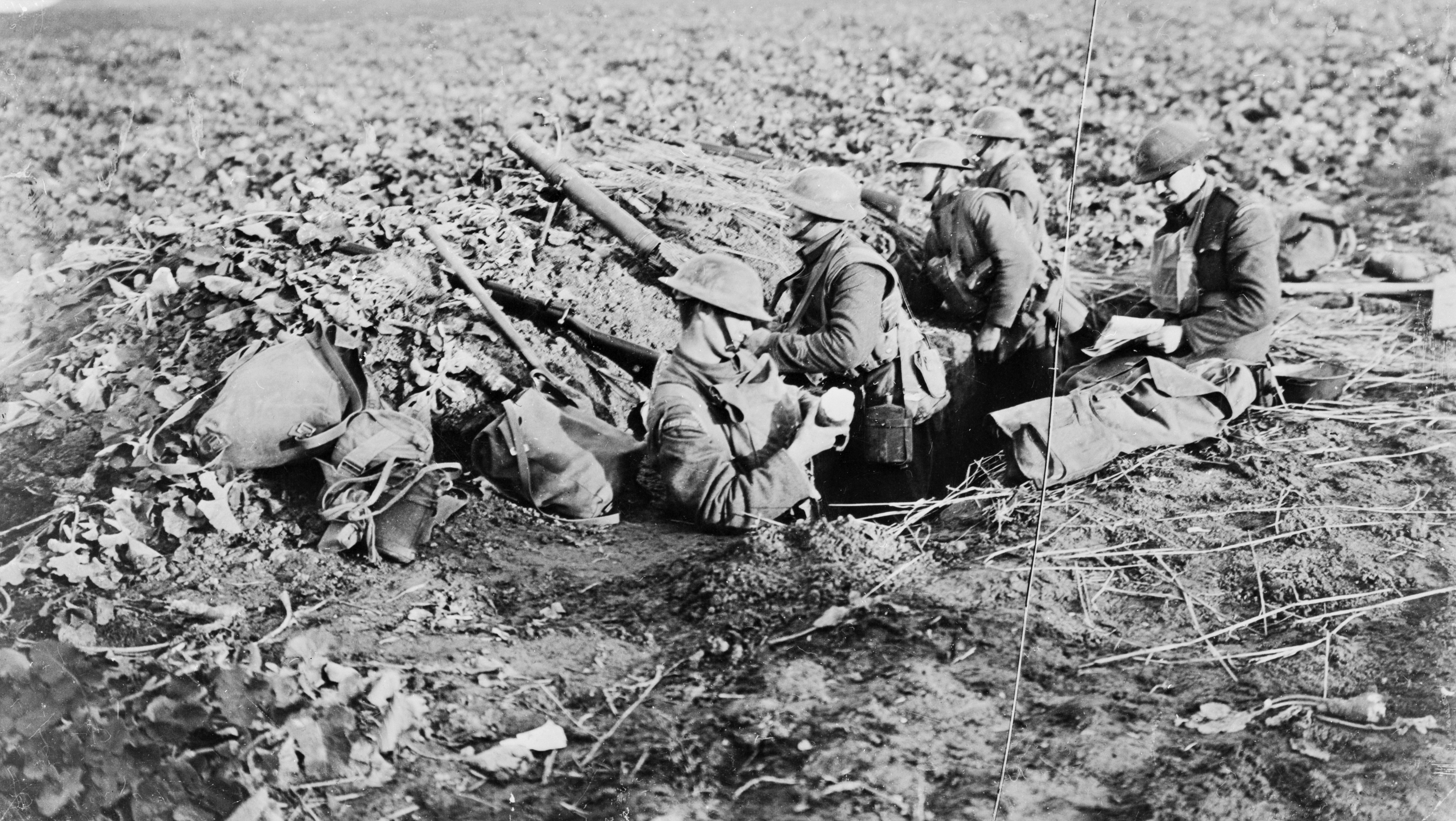On November 11, 1918, Armistice Day, the American Expeditionary Forces (AEF) on the Western Front in France suffered more than thirty-five hundred casualties, although it had been known unofficially for two days that the fighting would end that day and known with absolute certainty as of 5 o’clock that morning that it would end at 11 a.m. Nearly a year afterward, on November 5, 1919, General John J. Pershing, commander of the AEF, found himself testifying on the efficiency of the war’s prosecution before the House of Representatives Committee on Military Affairs.
The encounter was amicable and respectful since members were dealing with the officer who had led America to victory in the Great War. However, a Republican committee member, Alvan T. Fuller of Massachusetts, deferentially posed a provocative query: ‘This question is somewhat irrelevant to the matter under discussion,’ Fuller began, ‘but I would like to ask General Pershing if American troops were ordered over the top on the other side on the morning of the day when under the terms of the Armistice firing was to cease…and that those troops who were not killed or wounded marched peacefully into Germany at 11 o’clock. Is that true?’
Pershing answered with his customary crisp confidence:
When the subject of the armistice was under discussion we did not know what the purpose of it was definitely, whether it was something proposed by the German High Command to gain time or whether they were sincere in their desire to have an armistice; and the mere discussion of an armistice would not be sufficient grounds for any judicious commander to relax his military activities….No one could possibly know when the armistice was to be signed, or what hour be fixed for the cessation of hostilities so that the only thing for us to do, and which I did as commander in chief of the American forces, and which Marshal Foch did as commander in chief of the Allied armies was to continue the military activities….
Just days later, however, the congressman forwarded to Pershing a letter from a constituent with a cover note saying, ‘I have been deluged with questions on this subject.’ The enclosed letter had been written to Fuller by George K. Livermore, former operations officer of the 167th Field Artillery Brigade of the black 92nd Division, stating that that force had been engaged since 5 a.m. on November 11 and had been ordered to launch its final charge at 10:30 a.m. Livermore lamented ‘the little crosses over the graves of the colored lads who died a useless death on that November morning.’ He further described the loss of U.S. Marines killed crossing the Meuse River in the final hours as ‘frightful.’ Congressman Fuller closed his letter to Pershing asking for ‘a real frank, full answer to the question as to whether American lives were needlessly wasted.’
Fuller had Pershing’s answer within the week, and it was categorical. By allowing the fighting to go forward, Pershing reiterated that he was simply following the orders of his superior, Marshal Ferdinand Foch, commander in chief of Allied forces in France, issued on November 9, to keep up the pressure against the retreating enemy until the cease-fire went into effect. Consequently, he had not ordered his army to stop fighting even after the signing of the armistice, of which, ‘I had no knowledge before 6 a.m. November 11.’
The possibility of an armistice had begun the evening of November 7 when French soldiers of the 171st Régiment d’Infanterie near Haudroy were startled by an unfamiliar bugle call. Fearing they were about to be overrun, they cautiously advanced toward the increasingly loud blaring when out of the mantle of fog three automobiles emerged, their sides gilded with the imperial German eagle. The astonished Frenchmen had encountered a German armistice delegation headed by a rotund forty-three-year-old politician and peace advocate named Matthias Erzberger. The delegation was escorted to the Compigne Forest near Paris where, in a railroad dining car converted into a conference room, they were met by a small, erect figure–Marshal Foch–who fixed them with a withering gaze. Foch opened the proceeding with a question that left the Germans agape. ‘Ask these Gentlemen what they want,’ he said to his interpreter. When the Germans had recovered, Erzberger answered that they understood they had been sent to discuss armistice terms. Foch stunned them again: ‘Tell these gentlemen that I have no proposals to make.’
No proposals, perhaps, but he did have demands. Foch’s interpreter read aloud the Allied conditions, which struck the Germans like hammer blows: All occupied lands in Belgium, Luxembourg, and France–plus Alsace-Lorraine, held since 1870 by Germany–were to be evacuated within fourteen days; the Allies were to occupy Germany west of the Rhine and bridgeheads on the river’s east bank thirty kilometers deep; German forces had to be withdrawn from Austria-Hungary, Romania, and Turkey; Germany was to surrender to neutral or Allied ports 10 battleships, 6 battle cruisers, 8 cruisers, and 160 submarines. Germany was also to be stripped of heavy armaments, including 5,000 artillery pieces, 25,000 machine guns, and 2,000 airplanes. The next demand threw the German delegates into despair. Though the German people already faced starvation, the Allies intended to paralyze the enemy’s transportation by continuing its naval blockade and confiscating 5,000 locomotives, 150,000 railway cars, and 5,000 trucks. The translator droned on through thirty-four conditions, the last of which blamed Germany for the war and demanded it pay reparations for all damage caused. Foch informed Erzberger that he had seventy-two hours to obtain the consent of his government to the Allies’ terms, or the war would go on.
On average, 2,250 troops on all sides were dying on the Western Front every day. ‘For God’s sake, Monsieur le Marechal,’ Erzberger pleaded, ‘do not wait for those seventy-two hours. Stop the hostilities this very day.’ The appeal fell on deaf ears. Before the meeting, Foch had described to his staff his intention ‘to pursue the Feldgrauen [field grays, or German soldiers] with a sword at their backs’ to the last minute until an armistice went into effect.
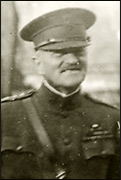 |
To Pershing the very idea of an armistice was repugnant. ‘Their request is an acknowledgment of weakness and clearly means that the Allies are winning the war,’ he maintained. ‘Germany’s desire is only to regain time to restore order among her forces, but she must be given no opportunity to recuperate and we must strike harder than ever.’ As for terms, Pershing had one response: ‘There can be no conclusion to this war until Germany is brought to her knees.’ The French and British Allies might be exhausted and long for peace, but Pershing saw his army akin to a fighter ready to deliver the knockout punch who is told to quit with his opponent reeling but still standing. Conciliation now, he claimed, would lead only to future war. He wanted Germany’s unconditional surrender.
The Germans finally yielded and signed the armistice at 5:10 on the morning of the eleventh, backed up officially to 5 a.m. and to take effect within Foch’s deadline: the eleventh month, eleventh day, eleventh hour of 1918. Pershing’s postwar claim that he had had no official knowledge of the impending armistice before being informed by Foch’s headquarters at 6 a.m. was disingenuous. The moment when the fighting would cease had been clear from the time Foch handed Erzberger the deadline, information to which Pershing was privy. On the evening of November 10 and through that night, news of the impending end was repeatedly affirmed from radio transmissions received at Pershing’s AEF headquarters in Chaumont.
After the general was apprised that the signing had taken place, the order going out from him merely informed subordinate commanders of that fact. It said nothing about what they should do until 11 o’clock, when the cease-fire would go into effect. His order left his commanders in a decisional no man’s land as to whether to keep fighting or spare their men in the intervening hours. The generals left in that limbo fell roughly into two categories: ambitious careerists who saw a fast-fading opportunity for glory, victories, even promotions; and those who believed it mad to send men to their deaths to take ground that they could safely walk into within days.
Congressman Fuller’s mention of the loss of marines that final day referred to an action ordered by Maj. Gen. Charles P. Summerall, Pershing’s commander of the V Corps. No doubt had clouded Summerall’s mind as to how all this talk of an armistice on the eleventh should be treated. The day before he had gathered his senior officers and told them, ‘Rumors of enemy capitulation come from our successes.’ Consequently, this was no time to relax but rather to tighten the screws.
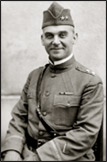 (National Archives)
|
Summerall, a fifty-one-year-old Floridian, had spent three years teaching school before entering West Point. By the time he arrived on the Western Front he wore ribbons from the Spanish-American War, the Philippine Insurrection, and the Boxer Rebellion. He was a severe, unsmiling, some said brutal man who liked to turn out in prewar dress uniform with copious medals, gilded sashes, and fringed epaulettes–suggesting a viceroy of India rather than a plain American officer. Because he had taught English, Summerall prided himself that he possessed a literary turn of phrase. ‘We are swinging the door by its hinges. It has got to move,’ he told his subordinates as he ordered them to cross the Meuse River on the war’s last day. ‘Only by increasing the pressure can we bring about [the enemy’s] defeat….Get into action and get across.’ His parting shot was: ‘I don’t expect to see any of you again, but that doesn’t matter. You have the honor of a definitive success–give yourself to that.’ Was he referring to ending his present command over them, or foretelling their fate? In either case, Summerall was spurring them on to defeat an already defeated enemy, whatever the cost.
Among replacements rushed to the Meuse was Private Elton Mackin, 5th Marine Regiment. Soon after America entered the war, Mackin had read an article in the Saturday Evening Post about the Marine Corps that lured the baby-faced nineteen-year-old to enlist. He had thus far survived 156 days at the front, beginning with his regiment’s bloody baptism in the battle for Belleau Wood. Whether he would survive the last day depended on General Summerall’s decision, and the human price it would exact.
In the gray hours before dawn on November 11, Mackin’s regiment stumbled out of the Bois de Hospice, a wood on the west bank of the Meuse. The night was frigid, shrouded in fog and drizzle as the marines tried to find their way to the river in the gloom. Army engineers had gone before them, throwing flimsy bridges across the water by lashing pontoons together, then running planks over the top. The first signs that the marines were headed in the right direction were the bodies they stumbled upon, engineers killed attempting to construct the crossings.
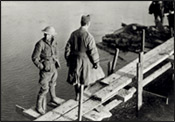 |
At about 4 a.m., the marines reached the first pontoon bridge, a rickety affair thirty inches wide with a guide rope strung along posts at knee height. They could see only halfway across before the bridge disappeared into the mist. Beyond, nothing was visible but the flash of enemy guns. The marines began piling up at the bridgehead, awaiting orders. A major blew a whistle and stepped onto the bridge. As the men crowded behind him, the pontoons began to sink below the water sloshing about the men’s ankles. The engineers shouted to them to space themselves before the span collapsed.
Enemy shells began spewing up geysers, soaking the attackers with icy water. German Maxim machine guns opened fire, the rounds striking the wood sounding like a drumroll, those hitting flesh making a’sock, sock, sock’ sound. The span swung wildly in the strong current. Mackin saw the man ahead of him stumble between two pontoon sections and vanish into the black water. The German guns’ bullets continued knocking men off the pontoons, like ducks in a shooting gallery. Still, the Americans kept coming. By 4:30 a.m. the marines and infantrymen of the 89th Division had taken Pouilly on the river’s east bank. In the remaining 6 1/2 hours they were to storm the heights above the town and clean out the machine gun nests. As day broke, Mackin watched a runner come sprinting across the bridge. The message from General Summerall’s headquarters read only, ‘Armistice signed and takes effect at 11:00 o’clock this morning.’ Again, nothing was said about halting the fighting in the meantime. Mackin survived to write of his experience. But the Meuse River crossings had cost more than eleven hundred casualties in the hours just before the war’s end.
Numerous members of Congress, including Fuller, had received appeals from families wanting to know why such pointless expenditure of life had been allowed to happen. Congress had already created a Select Committee on Expenditures in the War Department to investigate procurement practices, the sufficiency and quality of weaponry, and waste and graft in supplying the AEF. To this body, the House decided to add a ‘Subcommittee 3’ to investigate the Armistice Day losses. Royal Johnson, Republican from South Dakota, was appointed chairman to serve with another majority member, Republican Oscar Bland from Indiana, and a minority member, Daniel Flood, a Virginia Democrat. Johnson’s interest in the task assigned him was intensely personal. He was barely out of uniform himself. At age thirty-six, Johnson had taken leave from the House of Representatives and enlisted as a private in the 313th Regiment, ‘Baltimore’s Own,’ rising through the ranks to first lieutenant and earning the Distinguished Service Cross and Croix de Guerre.
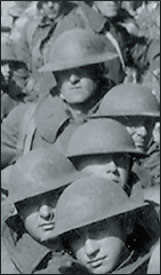 (National Archives)
|
Among the ranks of the 313th engaged on armistice morning was Henry N. Gunther, a fine-looking soldier in his mid-twenties, erect, with a clear-eyed gaze and a guardsman’s mustache that suggested a British subaltern rather than an American private. Gunther, however, had had difficulty with army life. He came from a heavily German neighborhood in east Baltimore where the culture of his forebears remained strong. When the United States went to war, Gunther and his neighbors began to experience anti-German prejudice. In this poisonous atmosphere, Gunther felt no impulse to enlist. He was doing nicely at the National Bank of Baltimore and had a girlfriend, Olga Gruebl, who he intended to marry.
Nevertheless, Gunther was drafted five months after America entered the war. His closest pal, Ernest Powell, became platoon sergeant in Company A, while Gunther was appointed supply sergeant. ‘Supply sergeants were traditionally unpopular,’ Powell recalled. ‘Army clothing in the war, as they said at the time, came in two sizes–too large and too small.’ Supply sergeants took the brunt of the soldiers’ gripes, and Gunther began keeping to himself, his enthusiasm for army life well controlled.
After arriving in France in July 1918, he wrote a friend back home to stay clear of the war since conditions were miserable. An army censor passed the letter along to Gunther’s commanding officer, who broke the sergeant to private. Gunther then found himself serving under Ernie Powell, once his coequal, a chafing humiliation. Thereafter, Powell observed Gunther becoming increasingly brooding and withdrawn.
By Armistice Day, the 313th had been engaged in nearly two months of uninterrupted combat. At 9:30 that morning, the regiment jumped off, bayonets fixed, rifles at port, heads bent, slogging through a marshland in an impenetrable fog toward their objective, a speck on the map called Ville-Devant-Chaumont. Its advance was to be covered by the 311th Machine Gun Battalion. But in the fog, the gunners had no idea where to direct their fire, and Company A thus moved along in an eerie silence. Suddenly, German artillery opened up, and men began to fall.
At sixteen minutes before 11, a runner caught up with the 313th’s parent 157th Brigade to report that the armistice had been signed. Again, the message made no mention of what to do in the interim. Brigadier General William Nicholson, commanding the brigade, made his decision: ‘There will be absolutely no let-up until 11:00 a.m.’ More runners were dispatched to spread the word to the farthest advanced regiments, including Gunther’s. The 313th now gathered below a ridge called the Côte Romagne. Two German machine gun squads manning a roadblock watched, disbelieving, as shapes began emerging from the fog. Gunther and Sergeant Powell dropped to the ground as bullets sang above their heads. The Germans then ceased firing, assuming that the Americans would have the good sense to stop with the end so near. Suddenly, Powell saw Gunther rise and begin loping toward the machine guns. He shouted for Gunther to stop. The machine gunners waved him back, but Gunther kept advancing. The enemy reluctantly fired a five-round burst. Gunther was struck in the left temple and died instantly. The time was 10:59 a.m. General Pershing’s order of the day would later record Henry Gunther as the last American killed in the war.
To question officers as to why men like Gunther had been exposed to death at literally the eleventh hour, the Republicans on Subcommittee 3 hired as counsel a recently retired army lawyer, Samuel T. Ansell. A forty-five-year-old West Pointer, Ansell had served as acting judge advocate general during the war and left the army specifically to take the congressional job for the then-substantial salary of twenty thousand dollars per year. His first move was to have all senior American commanders who had led troops on the Western Front answer these questions: ‘What time on the morning of November 11, 1918, were you notified of the signing of the armistice? What orders were you and your command under with respect to operations against the enemy immediately before and up to the moment of such notification and after notification and up to 11 o’clock? After receipt of such notification did your command or any part of it continue to fight? If so, why and with what casualties? Did your command or any part of it continue the fight after 11 o’clock? If so, why and with what casualties?’Ansell proved a fire-breathing pros-ecutor, ill concealing his premise that lives had indeed been thrown away on the war’s last day. Among the first witnesses he called was Pershing’s chief of operations, Brig. Gen. Fox Conner. Proud, ruggedly handsome, and a wily witness, Conner admitted that, pursuant to Foch’s order to keep the pressure on, one American army, the 2nd under Lt. Gen. Robert Lee Bullard, had actually moved an assault originally planned for November 11 up to November 10 ‘to counteract the idea among the troops that the Armistice had already been signed’ and ‘to influence the German delegates to sign.’
Not all commanders shared the view that Germany had to be pressured to sign. For days the Germans had shown no stomach to engage the Allies and carried out only rear-guard actions as they fell back. On armistice morning, the commander of the 32nd Division, Maj. Gen. William Haan, received a field telephone call from his subordinate commanding the 63rd Brigade asking permission to attack in order to straighten out a dent on his front. Haan retorted that he did not intend to throw away men’s lives on the war’s last morning to tidy up a map. The 32nd initiated no attacks while Haan’s men waited and took losses only from artillery fire.
Hotshot commanders nevertheless managed to find reasons to advance. Stenay was a town held by the Germans on the east bank of the Meuse. The 89th Division’s commander, Maj. Gen. William M. Wright, determined to take Stenay because ‘the division had been in the line a considerable period without proper bathing facilities, and since it was realized that if the enemy were permitted to stay in Stenay, our troops would be deprived of the probable bathing facilities there.’ Thus, placing cleanliness above survival, Wright sent a brigade to take the town. As the doughboys passed through Pouilly, a 10.5cm howitzer shell landed in their midst, killing twenty Americans outright. All told, Wright’s division suffered 365 casualties, including sixty-one dead in the final hours. Stenay would be the last town taken by the Americans in the war. Within days, it too could have been marched into peacefully rather than paid for in blood.
Bland, the other Republican on Subcommittee 3, knifed quickly to the heart of the matter when his turn came to question General Conner. ‘Do you know of any good reason,’ Bland asked, ‘why the order to commanders…should not have been that the Armistice had been signed to take effect at 11 o’clock and that actual hostilities or fighting should cease as soon as possible in order to save human life?’ Conner conceded that American forces ‘would not have been jeopardized by such an order, if that is what you mean.’
Bland then asked, regarding Pershing’s notification to his armies merely that hostilities were to cease at 11 a.m., ‘Did the order leave it up to the individual commanders to quit firing before or to go ahead firing until 11 o’clock?’ ‘Yes,’ Conner answered. Bland then asked, ‘In view of the fact that we had ambitious generals in this Army, who were earnestly fighting our enemies and who hated to desist from doing so…would it have been best under the circumstances to have included in that order that hostilities should cease as soon as practicable before 11 o’clock?’ Conner answered firmly, ‘No sir, I do not.’
‘How many generals did you lose on that day?’ Bland went on. ‘None,’ Conner replied. ‘How many colonels did you lose on that day?’ Conner: ‘I do not know how many were lost.’ ‘How many lieutenant colonels did you lose on that day?’ Conner: ‘I do not know the details of any of that.’ ‘I am convinced,’ Bland continued, ‘that on November 11 there was not any officer of very high rank taking any chance of losing his own life….’
Conner, visibly seething, retorted, ‘The statement made by you, I think, Mr. Bland, is exceedingly unjust, and, as an officer who was over there, I resent it to the highest possible degree.’
Bland shot back, ‘I resent the fact that these lives were lost and the American people resent the fact that these lives were lost; and we have a right to question the motive, if necessary, of the men who have occasioned this loss of life.’ With that, Conner was dismissed.
Also called to testify was the second highest ranking officer in the AEF, Lt. Gen. Hunter Liggett, who had commanded the First Army. Under questioning by the subcommittee’s counsel, Liggett admitted to Ansell that the only word passed along to the troops was that ‘the Armistice had been signed and hostilities would cease at 11 o’clock, Paris time.’ Ansell forced Liggett to agree that orders from AEF headquarters had left subordinate commanders in the dark as to their next course of action. The corpulent old general shifted responsibility to the commander on the scene ‘to judge very quickly from whatever was going on in his immediate neighborhood.’ Coupling Foch’s ‘keep fighting’ order and Pershing’s relaying of it, Ansell said, ‘I have difficulty to discover authority in any division commander under the terms of those two orders to cease advancing or cease firing on his front before 11 o’clock no matter what time he got the notice announcing the Armistice.’ Ansell added, suppose such a commander concluded: ‘I am in a situation where I can desist from the attack, and I am going to do so and save the lives of the men. Would you consider he had used bad judgment?’ Liggett did not hesitate: ‘If I had been a division commander, I would not have done that.’
At that point subcommittee Chairman Johnson interjected a personal experience in France occurring soon after the armistice while he was visiting a hospital: ‘I met several subordinate officers who were wounded on November 11, some seriously. Without exception, they construed the orders which forced them to make an attack after the armistice as murder and not war.’ Asked if he had ever heard such accusations, Liggett answered, ‘No!’ With that, he too was dismissed.
Brigadier General John Sherburne, former artillery commander of the black 92nd Division who had returned to civilian life, provided the Republican members of the subcommittee with what they most wanted: the views of a decorated noncareer officer who felt no obligation to absolve the army. A white officer with the division, Sherburne described the joy his black troops expressed near midnight on November 10 when the sky ‘was lighted up with rockets, roman candles, and flares that the Germans were sending up.’
This persuasive evidence of the approaching end was further confirmed, he said, when soon after midnight a wireless message intercepted from the Eiffel Tower reported: ‘The Armistice terms had been accepted and…hostilities were going to cease. My recollection is that in that wireless message the hour of 11 o’clock was stated as the time.’ Sherburne’s testimony made clear that the men in the trenches had persuasive information nearly twelve hours in advance that the war’s end was at hand, though Pershing had told Congress that he had had no knowledge that the armistice was about to be signed until he was notified at 6 a.m.
At Ansell’s urging, Sherburne went on to describe how he and his operations officer, Captain George Livermore, author of the letter to Congressman Fuller, had then telephoned divisional, corps, and army headquarters to find out, since the armistice had been signed, if an attack by the 92nd from the Bois de Voivrotte set for that morning could be called off. All up and down the chain of command, Sherburne testified, he was informed that the order stood. Ansell asked the effect of this order on the troops. ‘I cannot express the horror that we all felt,’ Sherburne said. ‘The effect of what we all considered an absolutely needless waste of life was such that I do not think any unit that I commanded took any part in any cel-ebration of the armistice, and even failed to rejoice that the war was over.’
‘Who in your judgment was responsible for this fighting?’ Ansell asked. Sherburne hesitated. ‘It is pretty poor testimony to have gossip,’ he answered. Ansell pressed him to go on. Sherburne then said:
I cannot feel that Gen. Pershing personally ordered or was directly responsible for this attack. If there is any obligation or liability upon him it is from not stopping what had already been planned….Our Army was so run that division and brigade and even corps commanders were piteous in their terror and fear of this all-pervading command by the General Staff which sat in Chaumont….They did not look upon human life as the important thing. In this, to a certain extent, they were right; you cannot stop to weigh in warfare what a thing is going to cost if the thing is worthwhile, if it is essential. But I think on the 9th and the 10th and the 11th they had come pretty near to the end of the War and knew they were pretty near the end. But they were anxious to gain as much ground as possible. They had set up what, in my opinion, is a false standard of excellence of divisions according to the amount of ground gained by each division….It was much like a child who had been given a toy that he is very much interested in and that he knows within a day or two is going to be taken away from him and he wants to use that toy up to the handle while he has it….A great many of the Army officers were very fine in the way that they took care of their men. But there were certain very glaring instances of the opposite condition, and especially among these theorists, these men who were looking upon this whole thing as, perhaps one looks upon a game of chess, or a game of football, and who were removed from actual contact with the troops.
It was, Sherburne went on, difficult for conscientious officers to resist direction from Chaumont, no matter how questionable. He admitted that even in a situation where his own life was at stake, he would have yielded to pressure from the general staff. ‘I would far rather have been killed,’ he told the subcommittee, ‘than to be demoted.’
The 33rd was another division engaged to the last minute. As the unit’s historian later described the final day:
Our regimental wireless had picked up sufficient intercepted messages during the early hours of the morning to make it certain that the Armistice had been signed at 5 o’clock that morning; and the fact that the prearranged attack was launched after the Armistice was signed…caused sharp criticism of the high command on the part of the troops engaged, who considered the loss of American lives that morning as useless and little short of murder.
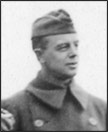 (National Archives)
|
|
|
The 81st Division took the severest blow that morning. One of its regimental commanders had told his men to take cover during the last hours, only to have his order countermanded. With forty minutes left in the war, the troops were ordered to ‘Advance at once.’ The division reported 461 casualties that morning, including sixty-six killed.
The army claimed to have put a hundred clerks to work on the subcommittee’s request for the number of AEF casualties that occurred from midnight November 10 to 11 o’clock the next morning. The figures provided by the adjutant general’s office were 268 killed in action and 2,769 seriously wounded. These figures, however, failed to include divisions fighting with the British and French north of Paris and do not square with reports from individual units on the ground that day. The official tally for the 28th Division, for example, showed zero men killed in action on November 11, but in individual reports from field officers requested by the subcommittee, the commander of one brigade alone of the 28th reported for that date, ‘My casualties were 191 killed and wounded.’ Taking into account the unreported divisions and other underreported information, a conservative total of 320 Americans killed and more than 3,240 seriously wounded in the last hours of the war is closer to the fact.
By the end of January 1920, Subcommittee 3 concluded its hearings. Chairman Johnson drafted the final report, arriving at a verdict that ‘needless slaughter’ had occurred on November 11, 1918. The full Select Committee on Expenditures in the War chaired by Congressman W.J. Graham initially adopted this draft.
Subcommittee 3’s Democratic member, Flood, however, filed a minority report charging that Johnson’s version defamed America’s victorious leadership, particularly Pershing, Liggett, and Bullard. Flood saw politics at work. The country had gone to war under a Democratic president. By 1918 the Republicans had won control of Congress, and it was they who had initiated the Armistice Day investigation. By the time the inquiry ended, Wilson’s hopes for the United States’ entering into the League of Nations were fast sinking and critics were questioning why America had gone to war in the first place.Flood suspected that the Republicans on the subcommittee were inflating the significance of the events of the last day, ‘trying to find something to criticize in our Army and the conduct of the war by our government.’ The committee, he claimed, had ‘reached out for those witnesses who had grievances….’ As for Ansell, whom he repeatedly referred to as the ‘$20,000 counsel,’ he had ‘been permitted to browbeat the officers of the Army.’ Flood also hinted that the lawyer had left the War Department, ‘with whom he is known to have quarreled,’ under a cloud. Finally, Flood argued that the select committee had been created to investigate wartime expenditures and not to second-guess generals on ‘matters beyond the jurisdiction of the committee.’
Flood’s dissent, with its patriotic ring, found enough sympathy that Chairman Graham took a rare step. He recalled the already approved Johnson report. Three hours of acrimonious debate followed.
In the end, Johnson bowed to pressure not to hold up the select committee’s report any further, and on March 3 he struck from his draft any imputation that American lives had been needlessly sacrificed on Armistice Day. The New York Times took the Dan Flood view, editorializing that the charge of wasted life ‘has impressed a great many civilians as being well founded….[But,] the civilian view [that] there should have been no shot fired if the commander of a unit had been notified of the signing is, of course, untenable….Orders are orders.’
American forces weren’t alone in launching assaults on the last day. The British high command, still stinging from its retreat at Mons during the first days of the war in August 1914, judged that nothing could be more appropriate than to retake the city on the war’s final day. British Empire losses on November 11 totaled some twenty-four hundred. The French commander of the 80th Régiment d’Infanterie received two simultaneous orders that morning: one to launch an attack at 9 a.m., the other to cease fire at 11. Total French losses on the final day amounted to an estimated 1,170.
The Germans, in the always-perilous posture of retreat, suffered some 4,120 casualties. Losses on all sides that day approached eleven thousand dead, wounded, and missing.
Indeed, Armistice Day exceeded the ten thousand casualties suffered by all sides on D-Day, with this difference: The men storming the Normandy beaches on June 6, 1944, were risking their lives to win a war. The men who fell on November 11, 1918, lost their lives in a war that the Allies had already won. Had Marshal Foch heeded the appeal of Matthias Erzberger on November 8 to stop hostilities while the talks went on, some sixty-six hundred lives would likely have been saved.In the end, Congress found no one culpable for the deaths that had occurred during the last day, even the last hours of World War I. The issue turned out much as General Sherburne predicted in his testimony. Soon, except among their families, the men who died for nothing when they might have known long life ‘would all be forgotten.’
Joseph E. Persico is the author of numerous books, including Roosevelt’s Secret War: FDR and World War II Espionage (Random House Trade, 2001). This article is based on his recently published book, Eleventh Month, Eleventh Day, Eleventh Hour: Armistice Day 1918, World War I and Its Violent Climax (Random House, November 2004).
This article was originally published in the Winter 2005 edition of MHQ. For more great articles, subscribe to MHQ: The Quarterly Journal of Military History today!

